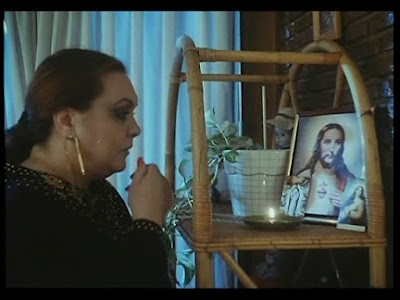Naschy plays Dr. Hugo Arranz, a successful surgeon, who is
spending his fiftieth birthday with his wife and teenage daughter at his
home. While they were shopping earlier
in the evening, a thug spied on them and noticed that Dr. Arranz carried a
large sum of money. This thug and his
crew have now invaded the Arranz home during dinner. They rape and murder Arranz’s wife. They rape and murder his daughter in front of
him, while he remains beaten and bound with his tongue cut out. The thugs presume Arranz dies, but he
survives. Now unable to speak, Arranz
hits the gym and pumps iron; conditions himself with jogging; and becomes
seriously adept at firearms and throwing knives. All that is left is to find the thugs
responsible for the deaths of his loved ones.
Back at his home, fresh from the hospital, Arranz finds a flyer for a
local bar. There is a name inscribed
upon the back, “Gloria.”
Naschy writes that, “It has been said that this film is a
copy of Death Wish, the film starring
the ever impassive Charles Bronson.
There is a grain of truth in that statement but I approached the film
from a totally Spanish viewpoint, with the Madrid criminal underworld in
mind. I wanted to make a movie that
reflected the sordid side of certain parts of the capital.” (1) Naschy was inspired to write the screenplay
after an experience that he had one evening leaving the gym. (2) He writes:
“Suddenly three scruffy youths appeared in front of me. They looked like they were out for
trouble. Two of them whipped out hunting
knives and I knew what I was in for. I
don’t know exactly what thoughts flashed through my mind at that moment, I just
reacted instinctively. Dropping my
sports bag to the ground I quickly unzipped it and got hold of the thick
protective belt used for power lifting.
I could feel rage boiling up inside me.
Maybe it was the pure anger of frustration that I’d had to hold back so
many times in my life or maybe I saw those thugs as a symbol of all the
bastards who’ve had it in for me down the years. The fact is I just went for them with a
vengeance and left two of them in a really bad way. ¶ It looked like I wasn’t going to be so
lucky with the third assailant but, fortunately, the headlights of a passing
car put the wind up them and they made a run for it.” (3)
Naschy’s screenplay also embraces the current discourse in
regards to the current system of justice, criminals’ rights vis-à-vis the
rights of their victims. Clearly Naschy
sides with the victims. For example, the
character of Olga, a magistrate and close friend of Dr. Arranz, advocates for a
better criminal justice system and reforming jails and prisons to make them
true rehabilitation facilities. The
thugs who assault Dr. Arranz’s family later gang rape the woman in her
garage. Subsequent to her assault, now a
victim, Olga ceases to be a staunch advocate for criminal rights but she does
not wholly abandon her causes. I believe
Olga, like Naschy with his screenplay, sees the issue as not a completely
academic one and one which must confront the rights of victims.
Naschy never abandons his lofty ideals in Night and he certainly is not reticent
to put the sensationalism on display. In
a creative scene, Arranz busts through a window like The Terminator upon two
thugs in their apartment. He ices one
with his magnum, and with the other, the lone female in the group of thugs who
attacked his family, he hesitates.
Naschy’s character has a Bergman/Von Sydow/Virgin Spring moment, where he can see his criminal as human when
begging for mercy. However, Arranz is so
overcome with vengeance that he cannot stop his parade of violence. He ices her.
(This character was shown earlier castrating a guy.) The thugs who attacked Arranz’s family are
part of a larger syndicate who are run by “Cobra,” whose face is never seen by
the viewer until the final act. In my
favorite scene of Night, two thugs
report to Cobra for orders. Cobra is in
an S&M session and only stops when his thugs enter the room. In a nifty shot, his portrait is shown but he
is hidden behind his S&M mask. (I
don’t know why but I find this hilarious.)
Finally, I believe Naschy’s son, Sergio, appears later in the film. He is an adolescent boy who lives near Dr.
Arranz’s country home. Arranz has housed
Gloria there, in order for her to have a home while she puts her life
together. This adolescent boy meets a
very ignominious ending during the final act shootout.
Despite The Night of
the Executioner being filmed and released in the early nineteen-nineties,
Naschy’s visual style and story content feel straight out of the nineteen-seventies in true grindhouse
fashion. Paul Naschy plays a bad
motherfucker in this one, and it is highly recommended for fans of his work.
1. Naschy, Paul. Memoirs of a Wolfman. Translated by Mike Hodges. Midnight Marquee Press, Inc. Baltimore, Maryland. 2000: p.205.
2. Ibid.
3. Ibid.





No comments:
Post a Comment